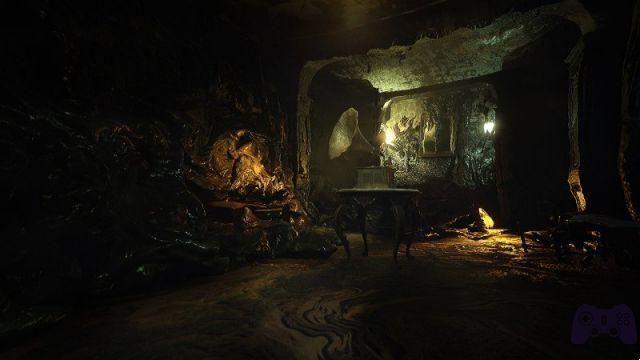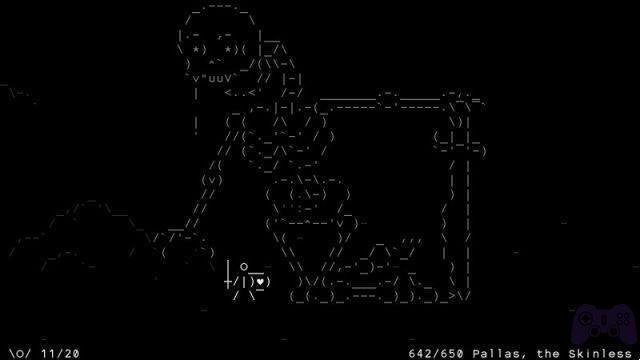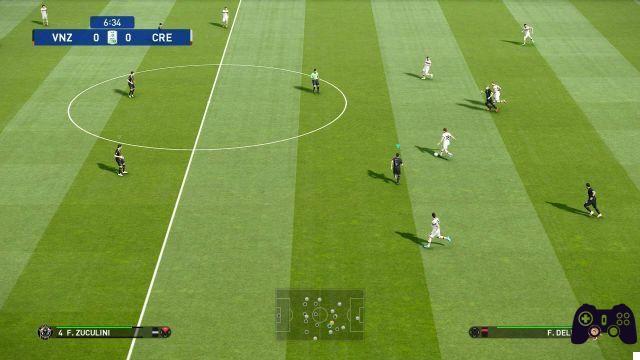It has been eleven years since an unpublished episode of Super Mario Bros. has been released, the two-dimensional branching of the plumber's adventures or, to define it better, that part of his DNA that constitutes the root and trunk of his story, from which the fronds with karting and tennis, golf and parties, plus the splendid three-dimensional foliage. This long hiatus is mainly due to the fame that New Super Mario Bros. has gained over time: it is not that a bad chapter of the series has ever been released, but too many (four) in a short time (six years) . , with settings and contents and decorations reiterated without restraint, in a saga (the "New", in fact) that, by its nature and genesis, was mannerist even before it was born. It can finally be said that those times are over: we explain why in Super Mario Bros. Wonder Review, available October 20 on Nintendo Switch.
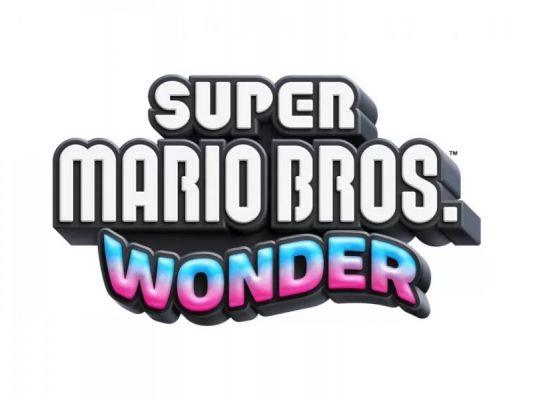
Rarely has a game logo been as illustrative and "speaking" as that of Super Mario Bros. Wonder: there is the very nature of the work. The writing "Super Mario Bros." is very similar to that of the "New" episodes, and in fact this new adventure does not repudiate its more recent relatives: the physics and controls are very similar, and certain graphic elements - surfaces, architecture - too faithful to the appearance - proposed and re-proposed - of those titles. Just below, however, is the wavy, colorful inscription "Wonder." Well, this work could be summarized like this: Nintendo has taken an extremely conventional base and has seasoned it at certain points with a hallucinogenic potion. We would talk about the Bronzino stained by Magritte, if it were about painting. A strange combination, difficult to imagine, and in fact the ingredients of Super Mario Bros. Wonder do not always combine perfectly: at the same time, certain moments exude creativity, and in general, we could say "finally", we are faced with a brave episode of the two-dimensional series.
We would like to affirm that Super Mario Bros. Wonder, despite everything, belongs more to the "New" family than to that of Super Mario Bros. for NES and SNES. But, although he is part of the family, he is clearly the half-crazy cousin, the Paperoga of the Maresco universe. We'll tell you why.
Inspirations and surprises
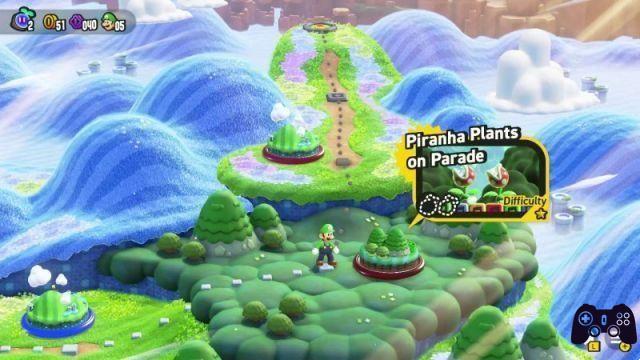
It is clear that Nintendo's creatives have thought a lot about how to renew the series and, at the same time, not completely renounce that base of extreme commercial success, and now also a source of nostalgia (for generation Z it was one of the Super Mario of childhood/early adolescence), of the "New". Instead of continuing to operate in parallel with the three-dimensional series, developed in Tokyo (and without even comparable critical prestige), they studied it and took it as inspiration. This is a somewhat symmetrical operation to that practiced by Super Mario 3D World in the past: if the latter tried to integrate the sensations and rhythm of two-dimensional Marios in a 3D context, Super Mario Bros. Wonder recycled its use. from the map. Which in some cases is open, and presents the scenarios in the same way: with a name - no longer a number - and a reproduction of them in a polygonal miniature. The intention is clearly to make each route unique.
Precisely in order to characterize each stage, there is a lot of Super Mario Galaxy in this game. What for video game and Nintendo enthusiasts is a timeless classic, but for many Switch owners is something unknown: for this reason, certain content will seem like too direct references, although translated into a different context, but to the majority of public, we imagine. - will still look new. Be that as it may, Wonder's vocation is to make each level memorable, and there is nothing more "Galaxy" than this.
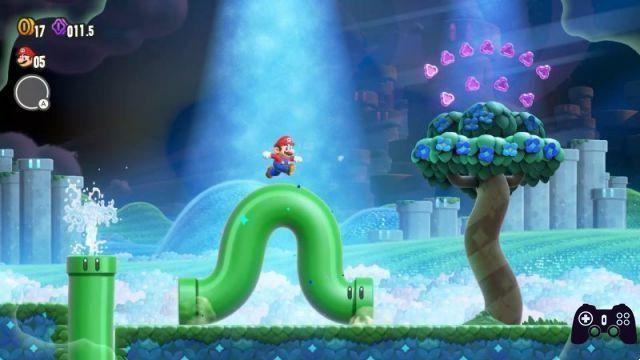
On almost every path there are two Wonder Seeds: one is obtained by grabbing the iconic end-of-level flag, the other is hidden behind a Wonder Flower, which in most cases is optional. The latter represents the main way in which Nintendo tries to surprise the player: if the traditional Super Mario Bros. are structured in a formula from point A to point B (or C, in the case of the hidden exits, also present in Wonder) , in this work everything is modified with an additional (and, we repeat, optional) internal path from X to Y, which can be activated by collecting the Wonder Flower. The limitations we have in describing the effects of Flowers are more than strict, so we cannot offer you practical examples. The point is this: if at this point in the review we were to YELL, AND MAYBE START TALKING ABOUT TENNIS AND HOW ROGER FEDERER RETIRED THE SAME DAY NINTENDO WAS FOUNDED, MAYBE WE WOULD BE UNPROFESSIONAL, AND WE WOULD DEFINITELY LEAVE THE TOPIC, but we would be funny. Wonder Flowers works essentially the same way.
In a relatively traditional structure, Flowers create something unusual and/or surreal. They are often successful in their endeavor, sometimes less so, but the desire to surprise is continuous. Each level in Super Mario Bros. Wonder is a little easter egg.
World class design.
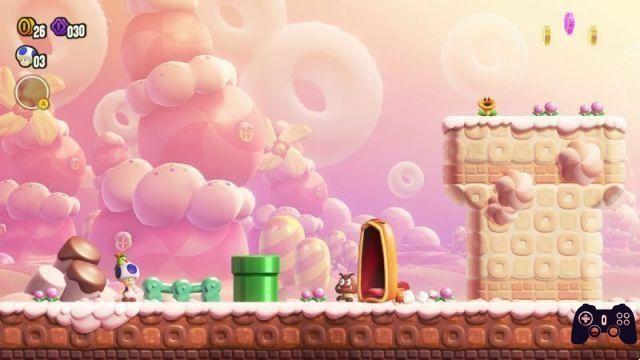
The maps of the different worlds alternate moments in which the paths are linear, so it is mandatory to go from one level to another, to other areas in which the protagonist can explore freely, accessing the different scenarios in the order they prefer. . Even here, we can't tell you in detail about the Worlds, but we would like to express a key concept of the game: the environments are not always brilliant but, unlike the "New" episodes, Nintendo has tried. in every possible way to create an internal coherence in Mario's journey, to give the feeling of an adventure in a fantasy world (in this case the flower kingdom, actually quite similar to that of the Mushrooms, if it weren't for the inhabitants, hostile or not). We reiterate: not all the new scenarios excited us, but at least the usual pattern, already known, was not repeated, and there is an internal structure that seeks coherence.
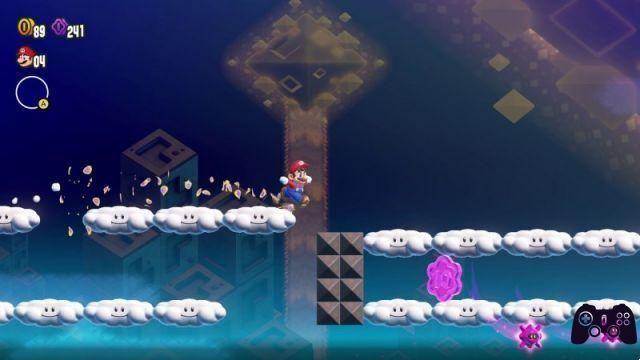
La difficulties The classification of the levels is indicated by the presence of some stars: from a minimum of one to a maximum of five. We haven't noticed any particular difference between the twos and threes, while there is a pretty clear gap with the fours, and especially the rare fives stages, which are really challenging. We'd go so far as to say that Super Mario Bros. Wonder contains the most difficult two-dimensional setting ever to appear in the series, despite being an averagely accessible game. To vary the experience, Nintendo has added short themed segments to the canonical levels: some to present a Pin (more on that shortly), others to create a surreal interlude or to generate a more thoughtful, puzzle-based experience. An appreciable introduction because it does not make up for the lack of content, but it integrates an already rich and full-bodied proposal, comparable to the previous episodes.
In each stage there are three purple coins, which are difficult to collect in the first round, and are used to integrate Mario's loot of purple money, necessary to buy objects and Seeds in the emporiums of the Poplins, the inhabitants of the Kingdom of Flowers . Nintendo has worked a lot on enemies that populate the scenarios: they do not propose extraordinary solutions, but they are still original, and they almost always generate functional dynamics to the design of the course levels. The recyclates of the past are only a minority, and it would have been foolish to exile the koopas and goombas from the series.
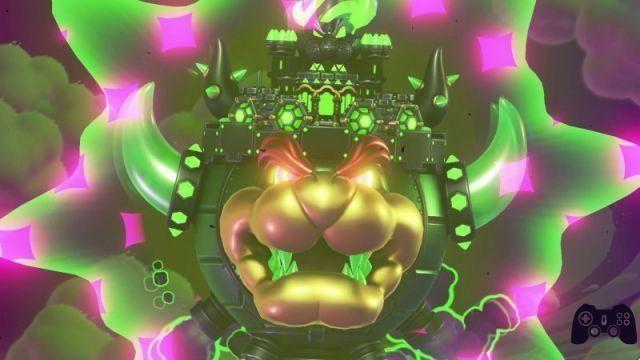
The most successful levels of Super Mario Bros. Wonder are those that integrate the detailed mechanics of the saga with the surprising effect of a Wonder Flower: the latter could at the same time deepen the level design of an internship, or turn it into a surreal context. The worst results, on the other hand, much rarer than the excellent ones, are those in which the level design is too traditional and the effect of the Flowers is predictable. However, most levels fall in the middle: some offer charming level design but a somewhat lackluster Wonder Effect, others exactly the opposite. However, each one, and this is what we appreciate the most, tries to be unique in something independently of the Wonder Flower: whether it is an enemy or a certain type of platform, or jumps in time to the rhythm of music. The only really negative note, in this sense, is represented by Bowser's Castles (and his descendants): too similar to each other and uninspired in boss battles.
Power on and play
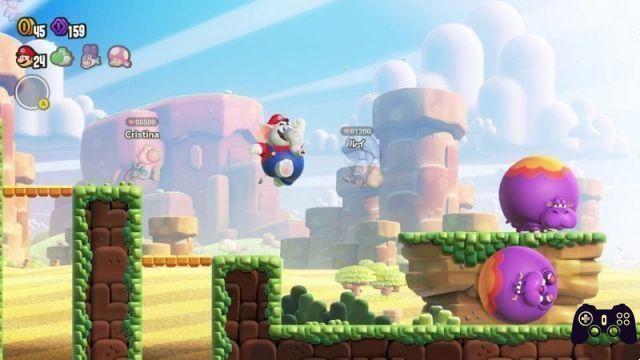
I Wonderful Super Mario Bros. power-ups. There are three: Elephant, Bolla and Drill. The best is undoubtedly the most iconic, the Elephant: both for its hilarious and clumsy appearance, accompanied by a variation of the musical arrangement that we loved, and for its multiple functions. None particularly pompous, all well structured: from the trunk that allows you to break blocks sideways to the ability to transport water and water flowers and objects. Drill looks like something out of Super Mario Galaxy and allows you to insert yourself into floors and ceilings by navigating inside: especially useful for finding secondary paths and killing certain types of enemies. The Bubble, on the other hand, allows you to (unsurprisingly) shoot soap bubbles, which envelop enemies (Bubble Bobble style) and can act as a springboard for the protagonist. One of the reasons why the Auger and Bolla will be less appreciated than the Elephant, functionality aside, is appearance: the latter is much more iconic and characteristic, and provides a complete transformation to the plumber. Perhaps it would have been better to act similarly with the others as well, while Bubble only changes the protagonist's costume and Drill adds a simple headdress.
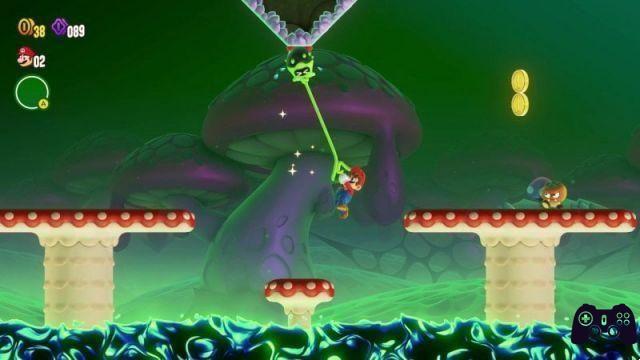
Le brooches They are the true novelty of the game, in terms of powers attributed to the protagonist. Unlike power-ups, one (and only one) must be selected at the beginning of each level. Some are designed to make the experience easier, others to give more possibilities to expert users. Whether it's an extra wall jump, a grappling hook to grab onto surfaces, a Pin that makes the character immune to first contact with lava. They are really very well modeled. Unfortunately, apart from brief stages illustrating how they work, they are rarely used specifically in level design: in practice, each level can be finished without them. In the aforementioned vocation of making each path unique, it seemed like a waste to us: it could have just been our hypothesis, but there is a particular stage that corroborated the thesis. Platforms and obstacles inserted specifically for a single Pin would have varied and deepened the game, while they are mainly used to horizontally diversify the experience and uncover secrets.
multiplayer, graphics and sound, longevity
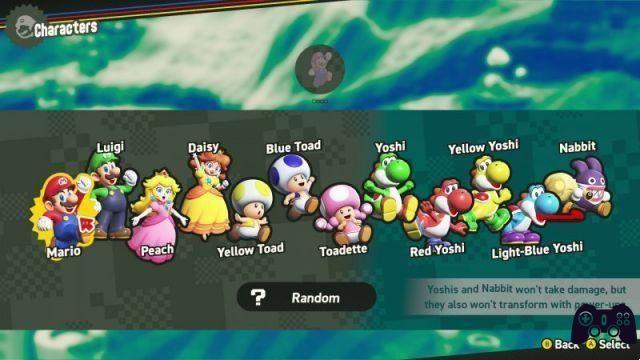
In Super Mario Bros. Wonder you can take control Many characters, as well as Mario: Luigi, Peach, Daisy, various types of Toad. They "only" change appearance, there is no difference in speed or jumping abilities, with the exception of Ruboniglio and Yoshi, who take no damage (but cannot take advantage of power-ups) and are designed for beginners. The dinosaur is usually capable of sliding and can be used as a mount, but only in multiplayer mode: no stage is designed, as was originally the case in Super Mario World, for its use.
Il multiplayer Offline reaches up to four players, but unlike the "New" characters they cannot help each other. This choice makes the adventure clearer and more precise, in the sense that users share the scenario without physically interacting and, therefore, without advantages but also without involuntary (or voluntary) annoyances. Playing online means, unless you arrive at a friend's room, randomly meeting other users who are going through the same level: this not only makes the experience more "live", but is a smart way to help players to find secrets. It's a kind of real-time solution: if you see a user going to a place where there are no platforms, there is probably some secret hidden nearby. A bit like what happens in FromSoftware games. Of course, if you want to find everything yourself, we recommend turning off the functionality. Having a companion on the network also has another usefulness: once you die, instead of restarting from the last checkpoint, you will have a few seconds, in ghost form, to touch another player - or a silhouette left by them - . Often, in an intelligent way, he suggests a secret to you: returning to life.
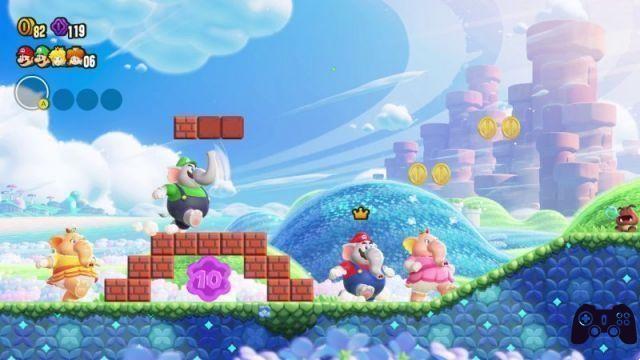
Graphically The most obvious quality of Super Mario Bros. Wonder lies in the animations.: You can see that Nintendo put a lot of work into the protagonists and enemies, and the effort really paid off. The main reason why this game is much prettier than the "New" ones lies precisely in this detail: Mario laughing when he jumps with his leg raised, the hat falling when he descends, the plumber picking up the helmet when he enters a pipe, the belly that swells in a particularly long jump, the elephant's buttocks that slow its entry into a tunnel. Furthermore, some backgrounds are truly remarkable and the soundtrack is of excellent quality: both in the music that accompanies them (in some levels Mozart's composition K525 is cited, or so it seemed to us, as in Mario Bros. from 1983) and in the catchiest melodies. , often associated with the effects of Wonder Flowers. In this sense, the true excellence is in the sound effects (the "sculata" with drum roll and crash of cymbals), but above all in the talking flowers planted here and there on the stages: sometimes they give useful advice, but in In general, their presence is characteristic on an aesthetic level, they are the ones who give the most successful surrealist touch with absurd and funny comments. It all works because they are dubbed with a mature voice: if it had been strident or grotesque, it wouldn't have had the same effect. The genius of the flowers lies precisely in the contrast between the absurd comments and the voice of a mature man.
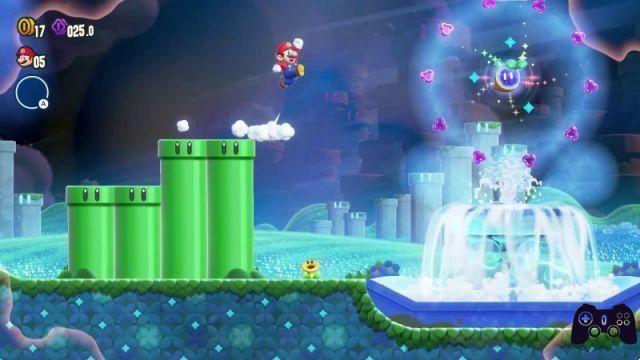
L'visual aspect The game also has some weaknesses. In particular, the plastic materials that cover each element of Super Mario Bros. Wonder - Nintendo has repeatedly proven to be a master at reproducing different surfaces, and the fact that everything here looks shiny, exactly like in the "New", e Regardless of the effect, whether intentional or not, it creates a moat with the adamantine quality of the animations. Likewise, the architecture and interiors, often inherited from the "New", are not at the level of the characters and the backgrounds: doors, columns, walls, would have deserved different attention.
We managed to complete Super Mario Bros. Wonder 100%. There is no game hour counter, but we should be around twenty/twenty-five. There duration varies greatly depending on the player's skill, but its duration, in practice, is slightly longer than that of the more recent two-dimensional Marios: however, unlike the latter, there are no secondary challenges to the main adventure and, from the " time", there is little point in playing trying to finish the route as quickly as possible.
Conclusions
digital delivery Nintendo eShop Price 59,99 € Holygamerz.com 9.0 Readers (96) 8.6 your voteAbracadabra: Super Mario Bros. Wonder continually tries to surprise the player and make each journey unique, in the level design and in the often absurd and sometimes magnificent effects of the Wonder Flowers. He has a character, an identity and an attention to detail that we haven't seen in a two-dimensional Mario for a long time: not only on a playful level, but also in the splendid animations, in the excellent sound accompaniment and in the adorable and absurd comments of the flowers speakers. It is a brave hybrid between mannerism and surrealism, the Paperoga of the family. It's a beautiful game and could have been a masterpiece, but it isn't. The relationship between the level design and the effects of the Wonder Flowers is not always optimal, the Castles are uninspired, some visual aspects are reminiscent of their predecessors, once 100% finished it does not offer particular incentives to play it again and, above all, All in all, the Snaps are designed to vary the experience and discover some secrets, not to shape and characterize the level design of the stages. It's the best two-dimensional Super Mario game of the last thirty years, excluding Yoshi's Island, and above all it's strange, unique, and hilarious. ALL'S WELL THAT ENDS WELL!
PRO
- Gorgeous character animations.
- Perfect controls, excellent level design.
- The absurd comments of the talking flowers
- Great character, often surprising.
AGAINST
- some forcing
- Pins are not used to their full potential.
- Interiors and architecture are not up to par with the rest.




